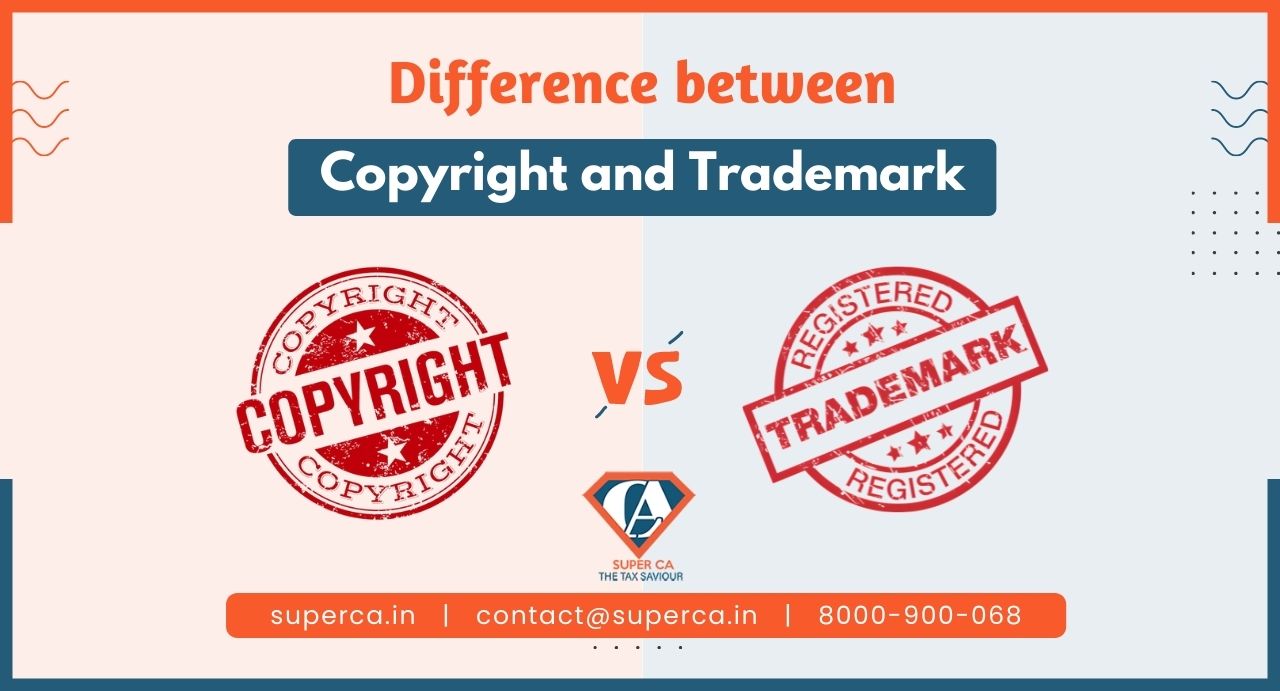What is the Difference Between Copyright and Trademark?


Just getting company registration is not safe in today’s era of cutthroat competition. Businessmen must get their trademarks registered and have copyright for their works which are used to identify goods or services from their company and at the same time ensure the protection of their creative work. With copyrights and trademarks, you can protect your business and take valid legal proceedings against those who use your brand and intellectual property without permission. If you're concerned with protecting your intellectual property, you might be wondering about the difference between a copyright and a trademark. In this blog, we'll discuss the basics of copyright and trademark and the difference between them so that you understand how to apply them to your business and, therefore, how to properly protect your intellectual property.
A copyright is a collection of rights that is provided to someone who creates an original work of authorship like a literary work, song, movie, software, writings, art, architecture, and music. Once you create original work and fix it, like taking a photograph, writing a poem/blog, or recording a new song, you are its sole owner. The copyrights provide you the right to reproduce the work, prepare derivative works, distribute copies, and perform and display the work publicly. Copyright also provides the owner of copyright the right to authorize others to exercise these exclusive rights, subject to certain statutory limitations.
For as long as the copyright is in effect, the copyright owner has the sole right to display, share, perform, or license the material. One notable exception is the “fair use” doctrine, which allows some degree of distribution of copyrighted material for scholarly, educational, news reporting, and any other related purposes.
A trademark protects words and design elements that identify the brand of a product. It includes all kinds of representations used by companies to distinguish their product from that of others in the market. Brand names and corporate logos are primary examples of trademarks. Therefore, a business can’t use a symbol or brand name if it looks similar, sounds similar, or has a similar meaning to one that’s already registered, at least if the products or services are related. If the trademark holder believes there’s a violation of these rights, it may decide to sue.
|
Basis |
Copyright |
Trademark |
|
Purpose |
The purpose of copyright is to make sure that the creation of the creator is protected by giving them the exclusive right to utilize or distribute their creation. |
The purpose of the usage of trademarks by businesses is to make sure that the identity or distinctiveness of their product/service is retained. |
|
Governing Act |
Copyrights in India are governed by the Indian Copyright Act enacted in the year 1957. |
Trademarks in India are governed by the Indian Trademarks Act, 1999. |
|
Target objects |
Copyright is geared toward literary and artistic works, such as books and videos. |
A trademark protects items that help define a company brand, such as its logo |
|
Symbol |
The owner or creator can for their works and creations that have copyright use the ‘©’ symbol or the alphabet ‘C’ even without registering it. |
The products or services that are issued a trademark or a logo are allowed to use the symbols such as the ‘®’ sign, the ‘™’ sign, the ‘SM’ sign, and the ‘TMT’ sign. |
|
Duration of Protection |
In India, the duration of the validation of copyright issued is the lifetime of the creator plus sixty years for an individual owner. whereas a non-individual owner, the issued copyright may be valid for over sixty years from the date of the creation to the date when it was published. |
Trademark registration is valid for ten years and it can be renewed after every ten-year validation period gets over for protecting the trademark from competitors. |
|
Exclusivity |
The copyrighted work provided the owner or creator of that work exclusive rights to utilize the work for financial gains. |
The trademarks help businesses in protecting and retain the exclusivity of the products or services provided by them. |
By this time you must be clear that both copyright and trademark offer intellectual property protection, but they protect different types of assets. For example, ABC Company can trademark its name and logo but would copyright the works that it creates. Likewise, a poem written by Manohal Lal is copyrighted, and songs composed by Justin Bieber are copyrighted. The logo of Google and Apple are trademarked, and the tagline of Nike is trademarked. This protection provided by law encourages creativity and innovation and helps a country grow both in economic as well as cultural terms.
Also, Read:

|
Essential LLP Registration Documents: A Complete Checklist for Entrepreneurs Author: Rahul Singh 04 Apr, 2024
|
Get inspired by these stories.